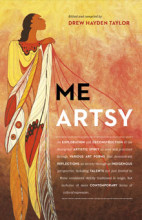Me Artsy
Edited by Drew Hayden Taylor
Douglas & McIntyre
266 pages, $22.95
Reviewed by Annabel Howard
Me Artsy, the third in a series of anthologies (Me Funny in 2006 and Me Sexy in 2008) edited by Drew Hayden Taylor, seeks to illuminate the practice of indigenous artists. Fourteen artists, whose mediums range from film, painting and dance, to drum-making, writing, cooking, and anime, write essays as various as the art forms they represent. As editor, Haden Taylor brings his own breadth as a playwright, novelist and script writer to the collection. Its range includes the highly academic (cultural theorist Karyn Recollet’s “For Sisters”), the personal (Zacharias Kunuk’s “The Story of my Life” and Maxine Noel’s “My Grandmother’s Eyes”), and even the practical (Uncle Richard Van Camp’s “Storytelling Tips”).
Despite this diversity, strong themes emerge as a reader pores over the articles. Hayden Taylor’s introduction focuses on identity, stating that art: “shows who we are, and what is important to us.” The theme of identity is picked up by many of the authors. For example, actor and playwright Monique Mojica believes it is her responsibility to recover both a personal and a cultural identity, and to proactively transform her people’s rage and sorrow into something positive for her community. Rose Stella, actor, singer and artistic director, places the arts at the centre of the “prevailing resurgence of Indigenous confidence, health, knowledge, identity and culture.” As she says in “Let’s Get Artsy – Yes, Let’s!”
“Identity is more than where you are from, your colour or a status card. Self-identity is about a calm self-confidence, a pride and belief in who you are and who your ancestors were.”
Art, Stella suggests, offers a portal to this identity, a chance for rediscovery and rebuilding.
A parallel, although separate theme, is that of the personal journey. It is unsurprising that many of the authors take this opportunity to situate their artistic practice not only within their discipline but within their community – many placing emphasis on how their work stems from and affects local, indigenous audiences, as well as how it speaks to North America as a whole. Many of the essays begin with biographical accounts: some shed light on what life was or is like on a reserve or – in the case of Zacharias Kunuk – to describe childhood on Baffin Island, with its experiences of seal hunting from a sod house in a community where nobody owned a television. Equally interesting is drum-maker Steve Teekens discussion of what it was like to encounter his own culture as a young adult, having grown up outside his first nation. A prevailing narrative within these autobiographical accounts is the importance of local support and native role-models. Many authors give thanks to people who paved their way – that is, made a future as a native artist seem a viable possibility. It was a pleasant surprise to encounter a divergence from the typical Western artist’s account of “personal struggle.” The struggles here are big enough to overwhelm the personal: something that should give pause for thought to today’s artists who are lucky enough to practice within the mainstream.
Through its 14 voices, Me Artsy does an admirable job of throwing light on the diversity of contemporary indigenous art production, as well as conveying how important the arts are for a sense of identity in the wider indigenous community. The book incites curiosity about the work of its artists, whilst allowing the authors some agency over how their work is received and evaluated. Although many authors acknowledge the injustices of the past, their voices cohere in a book that delivers more of a sense of celebration and maturity than agenda. “Uncle Richard” Van Camp perhaps best encapsulates the book’s overall message, with the following words: “No race has a monopoly on a better way of life. Every nation has something to offer us in the circle of life.”
Annabel Howard is a writer and critic with a background in art history.

{ 1 comment… read it below or add one }
From one Indian dud to another, great post! Cracked me up, my parents were the Canadian welcome co&e3ttemm#82i0;.so alot of this brings back memories. What’s up with Friday night language classes? Could there be a worse time in the week? My mother dragged us to Gujarati school and every week I tried to invent some illness so that I could avoid it. She sent us anyway….it stank like your couch after your cousins visit. Thanks for the read. Love jay.